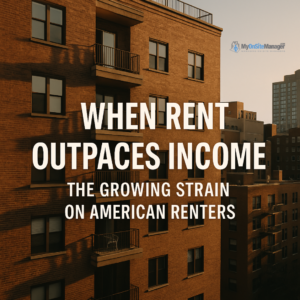For millions of Americans, keeping up with rent has become an increasingly difficult challenge. A striking analysis from the Center on Budget and Policy Priorities (CBPP) reveals that in nearly every U.S. state since 2001, rents have grown faster than renters’ incomes creating a widening gap that has reshaped the housing landscape.
Read the full CBPP article here
Rent vs. Income: A Widening Divide
Between 2001 and 2018, after adjusting for inflation:
-
Median renter household income rose just 0.5%.
-
Median rents, on the other hand, jumped nearly 13%.
This means that while wages barely budged, the cost of housing kept climbing. For the average renter, this imbalance has led to an increasing share of income being swallowed by rent.
The trend holds true across nearly every state, with only a handful showing rent and income growth moving at a similar pace. In places like California, Florida, and New York already known for high housing costs the disparity is especially stark.
What This Means for Renters
When rent grows faster than income, the real-life consequences ripple through households and communities:
-
Cost Burdens Rise: A growing number of renters spend more than 30% of their income on housing, officially “cost-burdened.” Those spending more than 50% fall into the “severely cost-burdened” category, where housing leaves little room for other essentials.
-
Less Financial Security: Renters with heavy housing costs often have to make trade-offs, cutting back on food, healthcare, or savings just to stay housed.
-
Increased Instability: Families facing high rents are more vulnerable to eviction, forced relocations, or homelessness.
-
Inequities Deepen: Communities of color, particularly Black and Latino renters, disproportionately face these challenges, compounding existing social and economic disparities.
Why Has Rent Outpaced Income?
Several structural factors have fueled this imbalance:
-
Tight Housing Supply – Decades of underbuilding, zoning restrictions, and rising demand have created severe shortages in affordable rentals.
-
Rising Costs to Build & Maintain – Materials, labor, and financing costs have all increased, and developers often focus on luxury units for profitability.
-
Wage Stagnation – While high-income earners have seen growth, wages for many working-class renters have barely kept up with inflation.
-
Stronger Landlord Leverage – In competitive markets with limited vacancies, landlords are able to raise rents with little risk of losing tenants.
The Human Impact
Beyond the statistics, this crisis plays out in daily struggles:
-
A family spending half its paycheck on rent has little left for savings or emergencies.
-
Young professionals delay milestones like buying a home or starting a family because they can’t get ahead while renting.
-
Seniors on fixed incomes face displacement from communities they’ve lived in for decades.
Housing instability not only affects individuals but also weakens neighborhoods leading to higher turnover, less community engagement, and greater demand for public assistance.
What Can Be Done?
Addressing the rent-income gap will require both immediate relief and long-term reforms:
-
Expand Rental Assistance: Programs like housing vouchers can help struggling families afford stable housing.
-
Boost Housing Supply: Relax zoning restrictions, incentivize affordable housing development, and reduce red tape for new construction.
-
Support Wage Growth: Policies that raise wages especially for service and low-income workers can help incomes keep pace with housing costs.
-
Strengthen Tenant Protections: Eviction protections and rent stabilization laws can shield renters from sudden, destabilizing rent hikes.
Why This Matters Now
Housing costs aren’t just a financial issue they’re a foundation for stability, opportunity, and well-being. When rent outpaces income, it traps families in cycles of hardship and makes it harder to climb the economic ladder.
If policymakers fail to act, the divide will only widen, pushing affordable housing further out of reach for the very people who keep our communities running teachers, service workers, healthcare staff, and countless others.
Source:
Rents Have Risen More Than Incomes in Nearly Every State Since 2001 – Center on Budget and Policy Priorities https://www.cbpp.org/blog/rents-have-risen-more-than-incomes-in-nearly-every-state-since-2001

